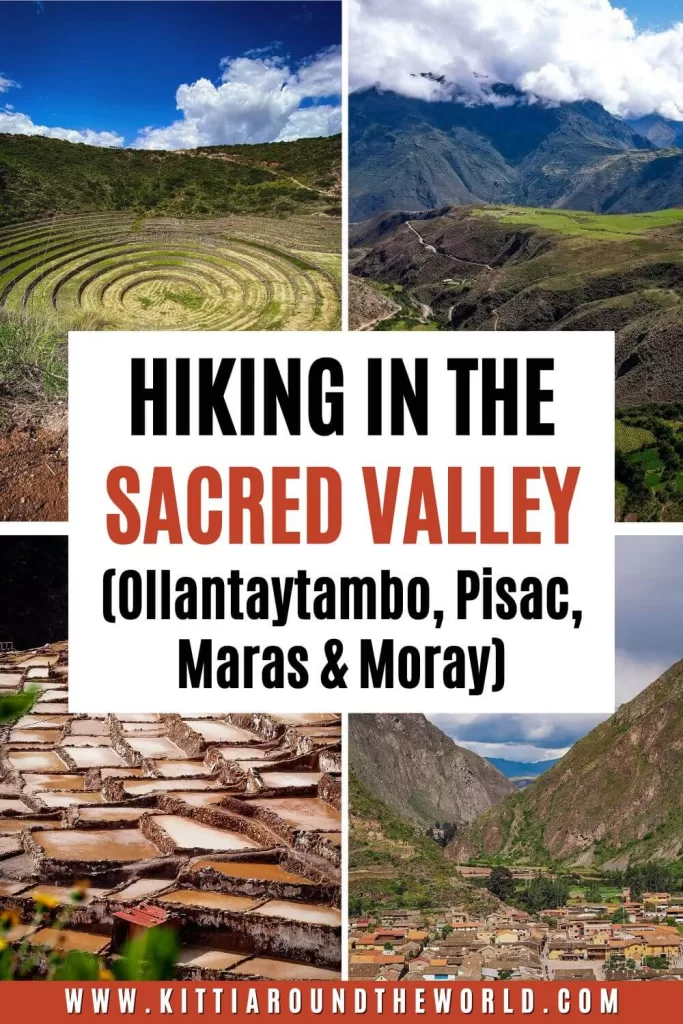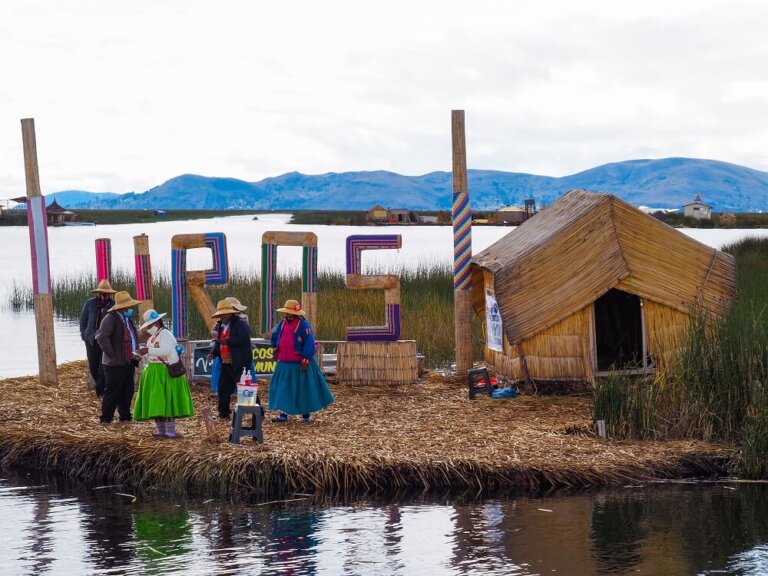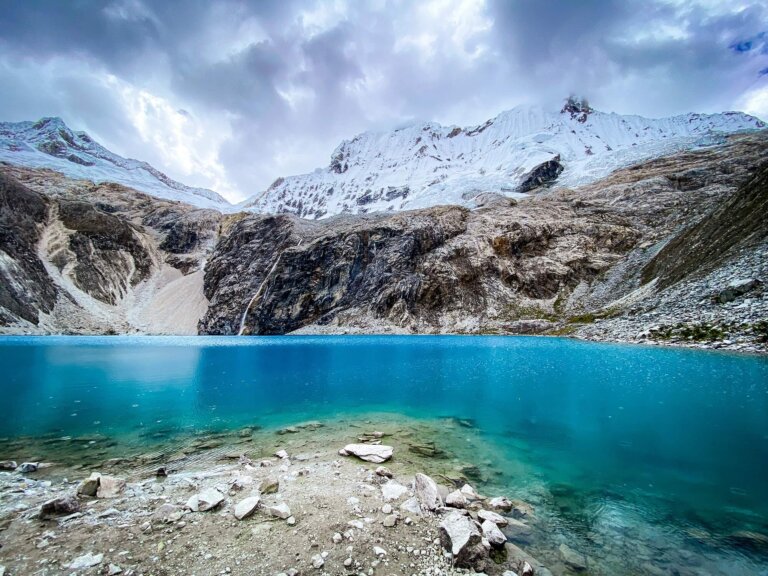Hiking in the Sacred Valley Without a Guide or Tour (Ollantaytambo, Maras, Moray and Pisac), Peru
If you’re planning on visiting and hiking in the Sacred Valley without a tour or a guide, then you’ve found the right blog post.
We were lucky enough to be able to spend an entire month in Cusco and had the time to go on an independent hike around the Sacred Valley to visit some of the most popular Inca Ruins such as Ollantaytambo, Maras Salt Mines, Moray Ruins and Pisac.
In this article you can see our detailed itinerary which will help you to easily plan your perfect hiking trip in this stunning part of Peru. The guide covers everything from transportation to hiking trails, where to stay to where to eat and how much this entire trip could potentially cost you.
If you’d like to see our Cusco and Sacred Valley adventures then check out the Peru Playlist on our YouTube channel.
Disclosure: This post may contain affiliate links, which means we may receive a small commission if you click a link and purchase something. Clicking these links won’t cost you anything, but it will help us to keep this site up and running! Learn more about our affiliate policy.
This blog post mainly focuses on how to plan a multi-day hiking trip in the Sacred Valley to visit Ollantaytambo, Maras, Moray and Pisac. We won’t go into too much detail about the individual sites as we’ve shared all that information in separate, dedicated blog posts. If you want to learn more about a certain location then you can do so by clicking on them below:

What is the Sacred Valley?
The Sacred Valley of the Incas (Valle Sagrado de los Incas in Spanish or Willka Qhichwa in Quechua) is located northwest of the city of Cusco. Formed by the Urubamba River, the valley stretches between the towns of Pisac and Ollantaytambo.
The elevation of most places you’ll visit in the Sacred Valley along the river is under 3,000m (9,800 ft) which is lower than Cusco’s altitude of 3,400 m (11,000 ft). Therefore, the Sacred Valley is a fantastic place to acclimatise. Of course, some of the mountain peaks surrounding the valley will have a height of over 5,000 m (16,000 ft), adding some unforgettable views to the landscape.
The Sacred Valley was once home to the Wari Culture between 500 and 1100 AD. Then the Inca slowly took over the valley from around the 12th century. The Inca gained even more power during the 14th century and expanded their territory into Ecuador, Chile, Bolivia, Argentina and Colombia.
Due to the valley’s close proximity to the Inca’s capital, Cusco, the lower altitude and better climate was favoured by the Inca to grow maize (corn). They built many cities, agricultural terraces, religious and military buildings across the valley.
Then the Spanish arrived around 1531 and eventually took over the area. They destroyed many temples and built churches in the valley.
Today, agriculture is still one of the main activities of the people living in the Sacred Valley. The area has also become a popular place amongst tourists.



3-Day Hiking Itinerary in the Sacred Valley
Below is our exact 3-day hiking itinerary. You can customise it as much as you wish to fit your interests.
Top Tip. If you’re short on time, you can complete this route in reverse order starting from Pisac and finishing in Ollantaytambo. That way you can head straight to Aguas Calientes on an afternoon train to visit Macchu Picchu the next morning. (In case you’re not completing the Inca Trail or the Salkantay Trek).
Day 1: Ollantaytambo
On your first day you can head to Ollantaytambo to explore the town and its famous ruins. Below is how you can plan out your day.
- Get from Cusco to Ollantaytambo with either a colectivo or taxi. Click here for more details on how to get to the town.
- Spend a few hours exploring the Ollantaytambo Ruins. You can either hire a guide on site or walk around on your own.
- Go for a ‘menu del dia’ in Ollantaytambo.
- Wander around Ollantaytambo town. There are quite a few markets and other sites to check out as we mention in our dedicated blog post.
- Get a taxi or colectivo to your accommodation in either Urubamba or Moccopata, unless you want to stay in Ollantaytambo.



Day 2: Maras and Moray
On your second day of hiking in the Sacred Valley, we recommend visiting the beautiful Maras Salt Mines and Moray Ruins located just outside the town of Maras. Below is how you can plan out your day.
- Get to the trailhead from your accommodation with a taxi or colectivo. You can just start walking from your accommodation if you stayed in Moccopata. Click here to view our hiking map.
- Hike up to Maras Salt Mines.
- Spend at least 30 minutes admiring the salt pools and learn about their history. You’ll be coming in from the back entrance which gives you the chance to appreciate the scale of the site. You’ll have to buy your ticket at the main entrance and you’re not allowed to walk between the pools.
- Hike from the Salt Mines to Maras by following the route on our hiking map.
- Grab some snacks or lunch in Maras.
- Either hike or take a taxi to Moray Ruins. We recommend hiking if you can.
- Spend a few hours walking around the site and learn about its history.
- Hike back to Maras by following our hiking map.
- Take a taxi or colectivo to your accommodation in either Urubamba or Pisac.



Day 3: Pisac
On your last day of hiking in the Sacred Valley, you can walk around the huge Pisac Ruins, one of the most beautiful Inca sites in the area. Below is how you can plan out your day.
- Depending on where you’re staying take a colectivo to Pisac.
- Once in the town, hike up to Pisac Ruins from the town’s entrance and spend a few hours exploring the site. Hiking uphill will be great training for some longer treks such as the Inca Trail or Salkantay Trek.
- Either hike back down to town or take a taxi back to Pisac.
- Grab some lunch or a ‘menu del dia’ at one of the many cool restaurants in town.
- Wander around the Artisan Market in Pisac and buy some souvenirs if you haven’t already. It’s normally less pricey than in Cusco.
- Take a colectivo back to Cusco.

Cost of a 3-Day Hike in the Sacred Valley
Below we summarise how much your 3-day independent hike in the Sacred Valley could potentially cost you, so you can come prepared.
Top Tip. Make sure to have enough local currency on you to cover colectivo and taxi fares, entry fees, street food and anything that you might buy at the local artisan markets. Restaurants will likely have card machines but it’s always good to come prepared.
The below cost is normally per person, although if you travel with someone, then you’ll share the accommodation and taxi costs. However, you’ll have to double up on food and entry fees.
Transportation cost:
- Cost of colectivo to Ollantaytambo: S/.10 (3 USD). A taxi would cost you between S/. 100 – 200 (27 – 55 USD).
- Colectivo to your accommodation in either Moccopata or Urubamba: S/.2 to 5 (0.6 -1.75 USD). Taxi to your accommodation is around S/.40 (11 USD).
- Cost of a one way taxi ride to Moray Ruins: S/.30 (8 USD). It’s free if you hike!
- Colectivo to Urubamba from Maras: S/.5 (1.75 USD). Taxi would cost around S/.25 (7 USD).
- Colectivo from Urubamba to Pisac: S/.5 (1.75 USD). Taxi is around around S/.25 (7 USD).
- Colcectivo from Pisac to Cusco: S/.5 (1.75 USD). Taxi is around S/.100 – 150 (27 – 41 USD).
You may be able to catch a colectivo everywhere and make the cost of your transportation very affordable. However, we recommend bringing enough cash so that you have enough to get a taxi here and there if needed. We normally allowed an hour to wait for a colectivo to fill up, but after that we were willing to pay for a taxi.

Entry Fees:
- Boleto Turistico (Cusco’s Tourist Ticket): S/.130 (35.40 USD) for the Integral Ticket and S/.70 (19 USD) for the Circuit III Partial Ticket. The cost of the ticket will include entry to Ollantaytambo Ruins, Moray Ruins and Pisac Ruins. Click here to read more about the Boleto Turistico.
- Entry fee to Maras Salt Mines isn’t included in the tourist ticket and admission costs S/.10 per person.
Cost of Accommodation:
- You can get a room for a night starting from about 20 USD. You might pay extra if you have breakfast included but we would calculate spending at least 50 USD for two nights. You might find something for more or less depending on which season you’re visiting in.
Food Cost:
- You can try to stay at places that offer breakfast so you don’t need to spend extra time and money finding somewhere to eat every morning. Of course, you can always grab something cheap from the local supermarket or markets.
- ‘Menu del dias’ (menu of the day’s) are normally offered at many restaurants around lunch time. They can cost anywhere between S/.10 – 20 depending on where you’re eating.
- There are of course many restaurants where you can eat dinner too. Prices vary depending on where you’re eating, so you can spend as little or as much as you want to on food. Normally the ‘menu del dia’ filled us up at lunch time, so we only had something light for dinner.
- You need to calculate in any extra snacks, water and other drink costs that you’ll likely consume during your trip.

Other Costs:
- We found that the artisan markets in the towns were generally a bit cheaper than the markets in Cusco. If you’re planning on buying some souvenirs then consider buying it out here and not in Cusco. We absolutely loved Pisac’s market and found some really lovely silver jewellery pieces.
Where to Stay During Your Sacred Valley Hike
There are quite a few options when it comes to accommodation.
On your first night you can either stay in Ollantaytambo or get a colectivo or taxi to either Moccopata or Urubamba. For reference, we stayed here in Moccopata because it was closer to the trailhead to the Maras Salt Mines and meant we didn’t need to take additional transportation in the morning.
However, if you decide to stay in either Ollantaytambo or Urubamba, then the next morning you can hop in a colectivo or taxi bright and early and ask the driver to drop you off here on the map just before Moccopata.
On your second night, you can either stay in Urubamba or Pisac. If you stay in Urubamba, you’ll have to take a colectivo or taxi in the morning to Pisac. If you want to get a head start the next day and stay in Pisac for the night, then you’ll just need to get transportation to Pisac from Maras by going to Urubamba first. For reference, we stayed here in Urubamba and got a colectivo to Pisac in the morning.


What to Pack for Your Sacred Valley Hike
Clothing Items
Let’s talk about what to pack for hiking in the Sacred Valley. Ideally, you’ll want to carry a daypack that fits everything you’ll need for two nights.
In terms of a hiking outfit, we recommend packing both long trousers and shorts. The temperatures will change a lot depending on the time of day and what altitude you’re at. Dress in layers and pack waterproofs like a rain jacket too.
In terms of footwear, you can wear hiking boots or shoes that have good grip and support. However, the hiking trail is pretty good, so if you want to save space, you can complete it in normal trainers. We suggest packing some flip-flops or slides that you can change into after your hike when relaxing around your accommodation.
Obviously, make sure to pack everything you need for a few nights such as pyjamas, toiletries and so on.
Electronics
In terms of electronics, don’t forget to pack your phone and camera gear. Although you’ll be able to charge your phone at your accommodation, we recommend taking a portable charger just in case.
For extra entertainment, we also packed our Kindles and some playing cards.
Accessories and Other Items
In terms of accessories, we recommend taking a reusable water bottle, sun-cream, a hat or cap and sunglasses for protection. Lastly, but most importantly, have enough cash on you to pay for anything such as colectivos and entry fees.
We suggest having a basic first-aid kit with you with some painkillers, altitude tablets, band-aids and any prescribed medications in.
Make sure to have your ID card or passport with you in a waterproof case.
All in all, try to pack as lightly as you can because you’ll have to carry everything on your own.

What to Do with Your Extra Backpacks and Luggage?
If you’re travelling around Peru, chances are you’ll have a big luggage or backpack with you. We were on a one-year long sabbatical leave, backpacking through Mexico and South America before heading to Montenegro, Albania and then Turkey. So, it’s safe to say that we had everything but the kitchen sink with us.
You probably don’t want to carry your big backpack or luggage around.
The best option is to leave any extra bags at the hotel or hostel you stayed at in Cusco. Depending on your itinerary you might spend an extra night in that accommodation after your Sacred Valley hiking trip. Most places are happy to store your luggage for a night or two. Depending on your accommodation, you may or may not have to pay a small fee per night for this. Just be mindful if you’re carring a lot of valuable items such as laptops.
If you’re a slow traveller and are planning on spending an extended period of time in Cusco, then you can book a longer Airbnb stay – which normally gives you a discount – and then leave your bags there. You’ll be paying double accommodation this way, so try to calculate which option will be more cost effective and secure before your visit.

Final Thoughts on Hiking in the Sacred Valley
We absolutely loved hiking in the Sacred Valley. We’re so grateful to have had a longer stay in Cusco that allowed us to spend 3 days exploring some of these incredible Inca sites. Many people visit all 3 locations as part of a one day tour, which is a great option to have, but we definitely would’ve felt rushed.
We definitely had to be patient while waiting for colectivos to fill up on some of the routes as they are mainly used by locals. Sometimes we had to give up and go for a more expensive taxi ride, but all in all the cost of our 3-day independent hike was still pretty reasonable. We also just loved waking up super early and arriving to these popular sites before the tour groups and having the place all to ourselves.
Have you ever visited the Sacred Valley before? If so, how much of the area did you manage to see and what was your favourite place? If not, would you add a hike in the Sacred Valley to your itinerary? Let us know in the comments below.
Now, let your adventure begin,

Our Top Travel Resources
Accommodation: For hotels we always use Booking.com and Hostelworld for hostels. We also book longer stays on Airbnb or Vrbo.
Flights: To find the best flight prices we always check Skyscanner, Google Flights or WayAway. Then we also check the airlines’ websites too for comparison.
Car Rentals: We use Discover Cars when we want to rent a car as it compares local, national and international companies.
Activities: If we book organised tours we always check either GetYourGuide or Viator.
Foreign Currency: Whenever we can we prefer to pay in local currency and for that we always use our Wise card. We can easily withdraw money from the ATM or pay by card at most shops and restaurants.
Travel Insurance: We never go anywhere without travel insurance. You never know what will happen on your trip, so good travel insurance like SafetyWing can protect you in case of injury, illness, theft and cancellations.
eSIM and VPN: To get data abroad we use Airalo which is an app that allows you to download a prepaid eSIM to your phone in over 190 countries. Make sure to have a VPN to avoid hackers accessing your personal data when using public WIFI. We use Surfshark which is the only VPN that offers one account on unlimited devices.
Remember…It all starts with a Pin…










Thanks Kitti for another great blog! It really helps to understand the geography and how to get around and see places. The photos are great too.
Thank you Karan, we’re glad you found the post useful.